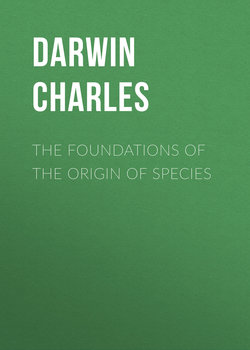Читать книгу The Foundations of the Origin of Species - Чарльз Дарвин, Darwin Charles - Страница 13
PART I
CHAPTER I
ON THE VARIATION OF ORGANIC BEINGS UNDER DOMESTICATION; AND ON THE PRINCIPLES OF SELECTION
Causes of Variation
ОглавлениеAttention must here be drawn to an important distinction in the first origin or appearance of varieties: when we see an animal highly kept producing offspring with an hereditary tendency to early maturity and fatness; when we see the wild-duck and Australian dog always becoming, when bred for one or a few generations in confinement, mottled in their colours; when we see people living in certain districts or circumstances becoming subject to an hereditary taint to certain organic diseases, as consumption or plica polonica, – we naturally attribute such changes to the direct effect of known or unknown agencies acting for one or more generations on the parents. It is probable that a multitude of peculiarities may be thus directly caused by unknown external agencies. But in breeds, characterized by an extra limb or claw, as in certain fowls and dogs; by an extra joint in the vertebræ; by the loss of a part, as the tail; by the substitution of a tuft of feathers for a comb in certain poultry; and in a multitude of other cases, we can hardly attribute these peculiarities directly to external influences, but indirectly to the laws of embryonic growth and of reproduction. When we see a multitude of varieties (as has often been the case, where a cross has been carefully guarded against) produced from seeds matured in the very same capsule194, with the male and female principle nourished from the same roots and necessarily exposed to the same external influences; we cannot believe that the endless slight differences between seedling varieties thus produced, can be the effect of any corresponding difference in their exposure. We are led (as Müller has remarked) to the same conclusion, when we see in the same litter, produced by the same act of conception, animals considerably different.
As variation to the degree here alluded to has been observed only in organic beings under domestication, and in plants amongst those most highly and long cultivated, we must attribute, in such cases, the varieties (although the difference between each variety cannot possibly be attributed to any corresponding difference of exposure in the parents) to the indirect effects of domestication on the action of the reproductive system195. It would appear as if the reproductive powers failed in their ordinary function of producing new organic beings closely like their parents; and as if the entire organization of the embryo, under domestication, became in a slight degree plastic196. We shall hereafter have occasion to show, that in organic beings, a considerable change from the natural conditions of life, affects, independently of their general state of health, in another and remarkable manner the reproductive system. I may add, judging from the vast number of new varieties of plants which have been produced in the same districts and under nearly the same routine of culture, that probably the indirect effects of domestication in making the organization plastic, is a much more efficient source of variation than any direct effect which external causes may have on the colour, texture, or form of each part. In the few instances in which, as in the Dahlia197, the course of variation has been recorded, it appears that domestication produces little effect for several generations in rendering the organization plastic; but afterwards, as if by an accumulated effect, the original character of the species suddenly gives way or breaks.
194
This corresponds to Origin, Ed. i. p. 10, vi. p. 9.
195
Origin, Ed. i. p. 8, vi. p. 10.
196
For plasticity see Origin, Ed. i. pp. 12, 132.
197
Var. under Dom., Ed. ii. I. p. 393.
